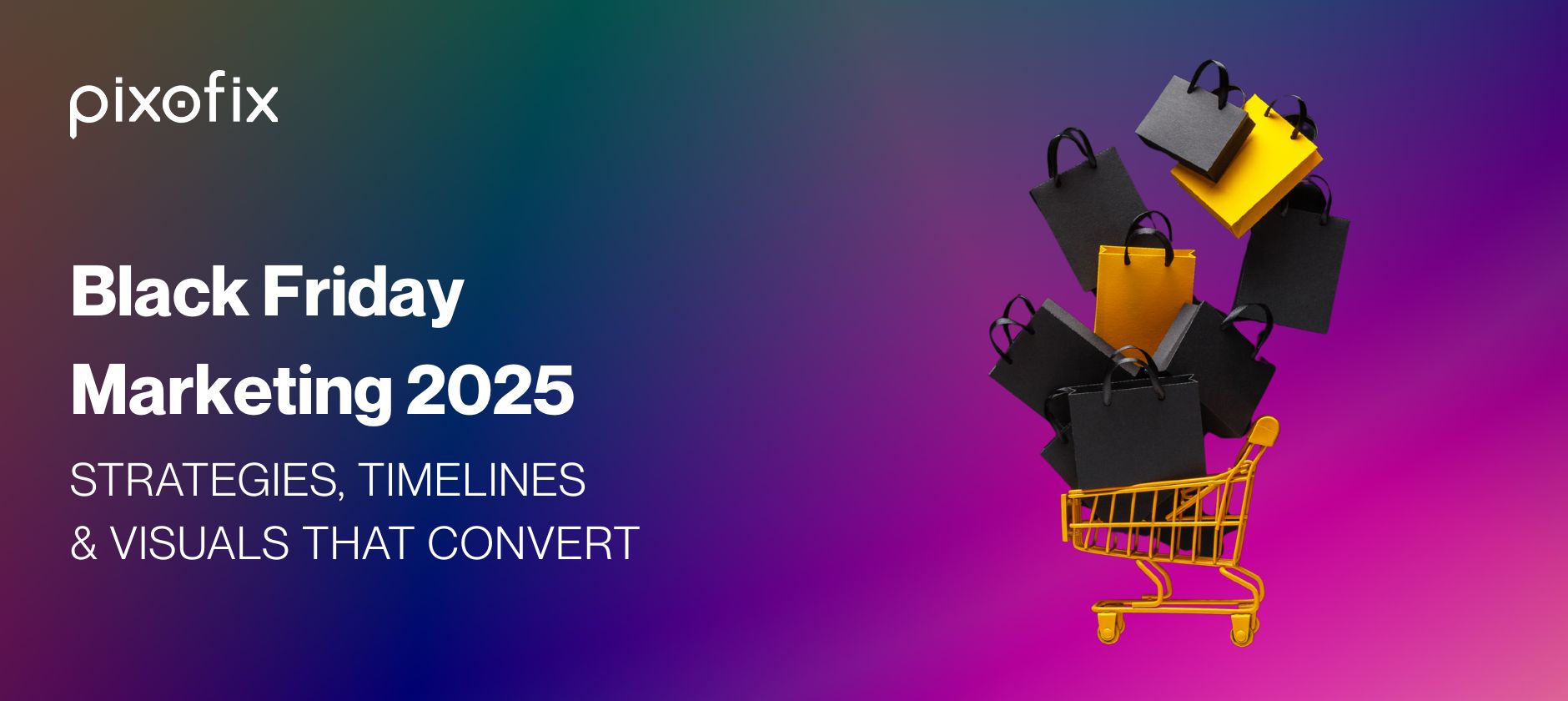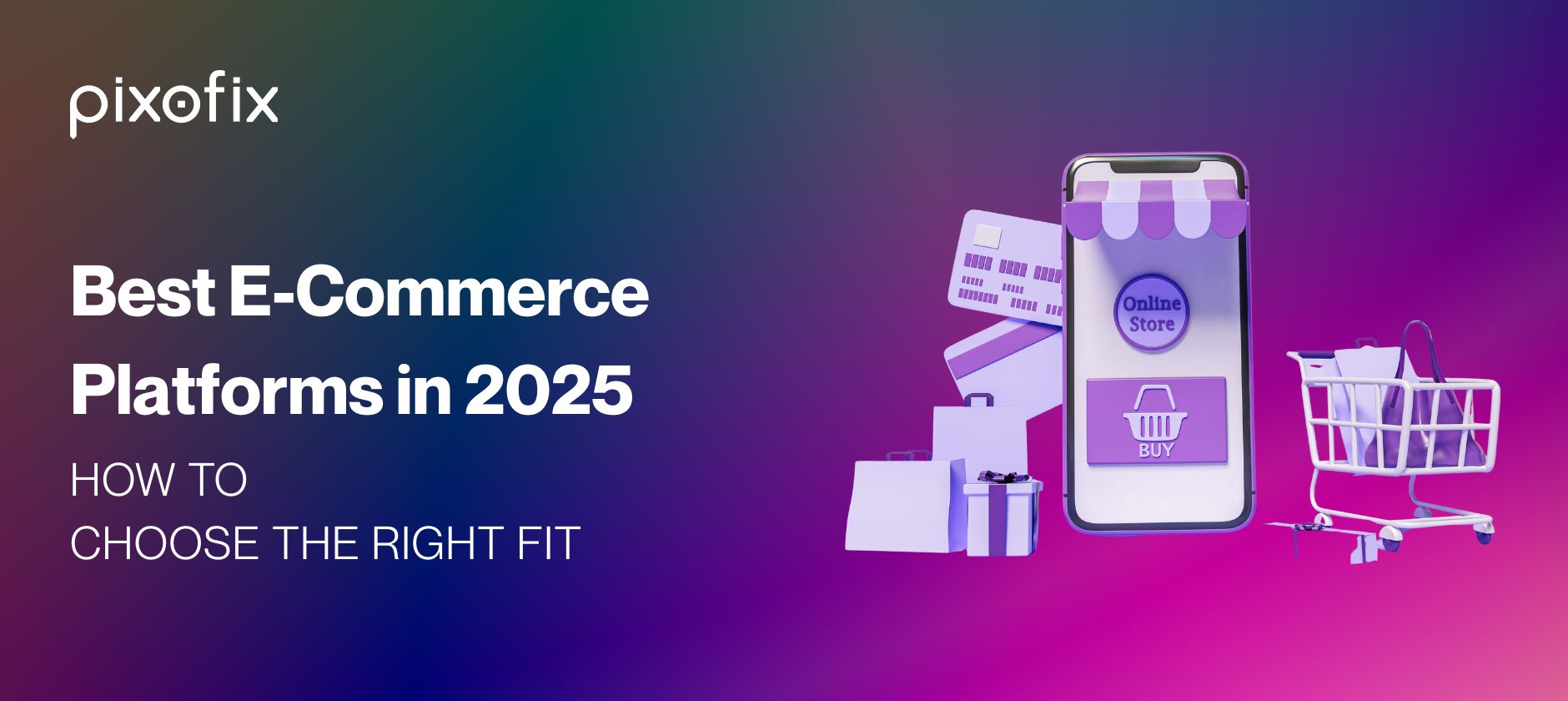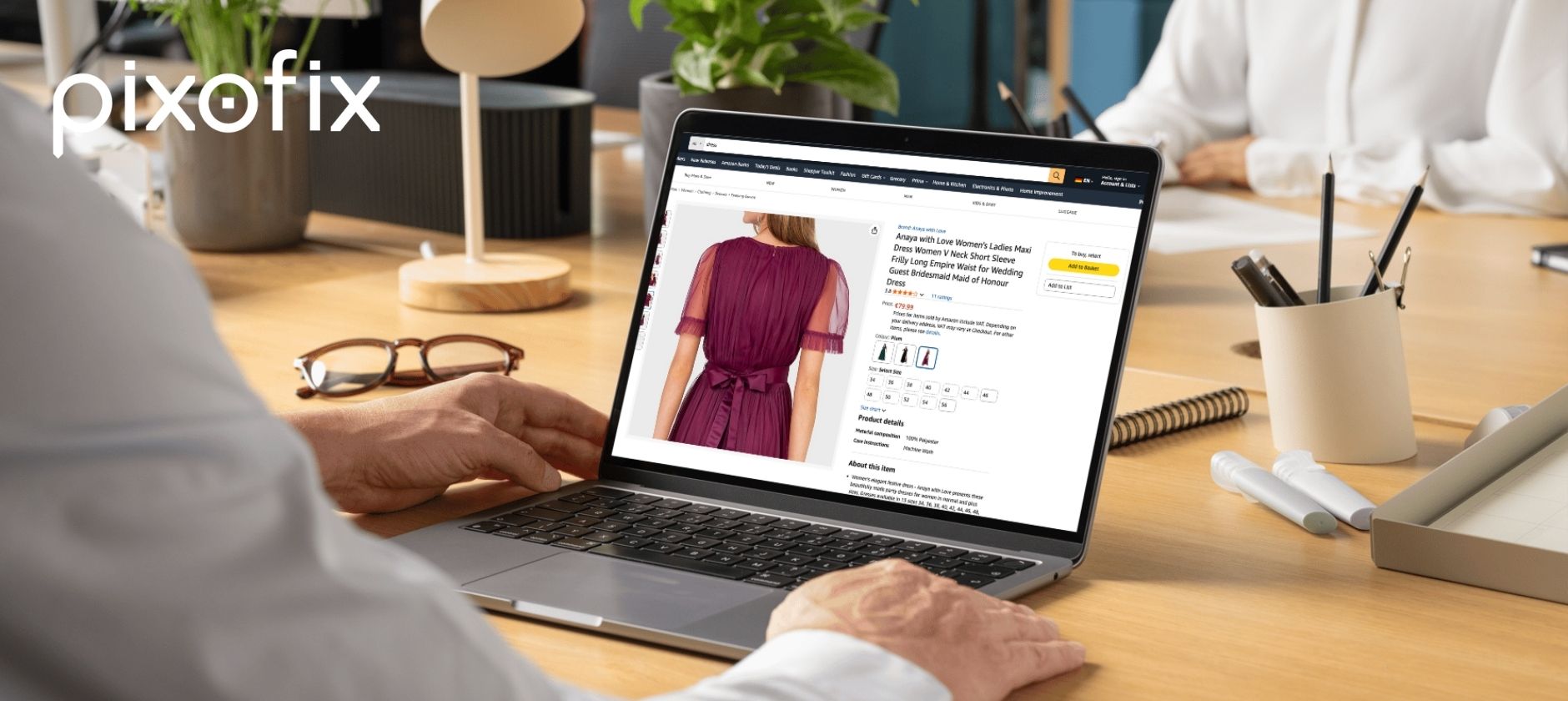Why Black Friday Marketing Matters for E-commerce
Black Friday is no longer just a shopping day. It’s the tension point in Q4 where attention, urgency, and spending collide. For e-commerce brands, it’s the ultimate performance stage. Buyers are primed to act fast — and they expect brands to show up ready.
Done right, Black Friday marketing doesn't just spike sales for a weekend. It builds lists, deepens customer relationships, creates remarketing fuel, and elevates your brand in a sea of discounts. It's also one of the few times visual content alone can move the needle. A single image — striking, scroll-stopping, unmistakably your brand — can outperform paragraphs of copy.
This is the moment when your ecommerce experience needs to work in sync: promos, visuals, tech, timing, and storytelling. Miss that synergy, and you’re just another email in a crowded inbox.
Understanding Black Friday Marketing Essentials
The Evolution of Black Friday Promotions
It used to be midnight madness: doorbusters, long lines, in-store chaos. Now, Black Friday starts in early November — or earlier. The rise of e-commerce transformed it from a one-day sprint to a month-long marathon of “drops,” “pre-sales,” and “members-only” access.
Retailers realized something crucial: time pressure is powerful, but exclusivity builds loyalty. As the timeline stretched, so did the strategy. Brands leaned into layers — email list previews, staggered discounts, limited-edition bundles. Design and visual content became central triggers, not just decorations. And thanks to integrated workflows and hybrid retouching teams like Pixofix, brands can now move fast without sacrificing quality.
Key Trends Shaping Black Friday Strategies
- Micro-campaigns instead of one giant push. Think segmented blasts and scheduled offers built for specific buyers.
- Mobile-first layouts with vertical visuals — because your audience is probably shopping from the couch.
- Fast, frictionless checkout. If your UX makes people think, you lose them.
- Stories and motion-rich content. Static is dead. Brands now use quick cuts, gif-style loops, or AR tools to pull shoppers into the product world.
- Hybrid content production. AI speeds up edits but human-led visuals still drive emotion. Forward-thinking teams, like Pixofix, layer both.
Effective Black Friday Marketing Strategies
Define Your Goals for Black Friday Campaigns
Start with clarity. Are you chasing a revenue bump? Building your list? Clearing inventory with precision? Each goal demands a different creative strategy — and you can't nail the visuals or messaging without knowing the end game.
If you're targeting LTV, focus on bundling and cross-sell flows. If you're brand-building, lead with visuals that deepen identity. If it's purely transactional, lean into urgency and deal visuals hard.
Build and Segment Your Email List
Your list is your launchpad. The more tailored your Black Friday messaging, the better it converts. Segment based on behaviors — purchase history, browsing patterns, campaign engagement. Then craft visuals for each group’s intent.
Abandoned browsers? Show them what they left behind with a standout product shot. High-value customers? Hit them with early access and premium vibes. Tools like Klaviyo or Omnisend help tie it together — but the message only lands if the visuals feel personal. That’s where having a photo partner like Pixofix in your pipeline is a major edge.
Utilize Countdown Timers for Urgency
Nothing compresses decision-making like a ticking clock. Whether it’s embedded in emails, banners, or product pages, countdown timers make stakes visible. Just make sure they’re synced across channels — sloppy or inconsistent timers erode trust.
Pairing timers with fast-loading, high-conversion imagery raises the pulse. Especially in mobile viewports, where a single hero image and shrinking timer can seal the deal.
Create Exclusive Early Access Offers
Early access isn’t just bonus time. It’s a reward. Framing it as VIP treatment gives campaigns teeth. Use scarcity-driven language ("Only 250 units opened early") and back it up with visuals that feel elevated — clean lighting, subtle luxury, confident negative space.
Better yet, use these moments to test your campaign visuals before your wider drop. A/B test product imagery, tonal shifts, or bundle presentation. With teams like Pixofix, feedback loops are fast enough to apply refinements within the same week.
Implement Interactive Elements and Gamification
Static banners get ignored. But “Spin to Win,” unlockable tiers, or visually rich quizzes? They slow the scroll. Interactive overlays or visual games not only boost time on site — they feed your dataset. Think click paths, drop-offs, intent signals.
Gamification doesn’t mean cartoonish. For a fashion or beauty brand, it might look like a shoppable moodboard that lets users “build their style” in exchange for a 20% code drop.
Use Personalized Discounts Based on Behavior
Not all buyers are created equal — and your discounts shouldn’t be either. Pull in browsing history, cart activity, and patterns leading up to Black Friday. Then align discounts with behavior intensity.
A first-time visitor who added-to-cart but bounced? Hit them with a 10% nudge and a retarget visual that emphasizes value. A Gold-tier loyalty user? Serve a curated bundle with a “just for you” note and premium images that feel like a thank-you, not a blast.
Optimizing Your Onsite Experience
Implement Pop-ups for Email Capture
Not spammy, not sloppy. The best Black Friday pop-ups are fast, modern, and branded to the pixel. Crisp lifestyle photos beat stock models every time. Motion, timing, and copy all matter — but if your image doesn’t make someone stop, it’s just noise.
Time your capture to intent. Pop-ups on exit or after 25 seconds of scroll signal thoughtfulness. Use dynamic content to offer value, like early access or a free gift tier.
Enable Cart Recovery Techniques
Carts go abandoned fast during Black Friday chaos. Recovery flows need to trigger within minutes, not hours. But here’s where the real difference lies: what’s in that reminder?
Recycled product shots won't cut it. Re-show the item with urgency baked into the visual: overlays, timers, or user-generated content to reinforce FOMO. AI tools help automate the flow, but your design and imagery carry emotion — and that’s what wins back the sale.
Showcase Real-Time Inventory and Shipping Information
Inventory signals create pressure. If only four units remain, say it — clearly, visually, and truthfully. Empty urgency backfires. Show limiting copy with an updated image or visual badge that matches your brand’s voice.
Shipping is just as critical. In Black Friday mode, delayed fulfillment kills trust. Be clear about timelines, even in visuals. A small icon (“delivers in 2 days”) layered into the product gallery beats fine print buried below the fold.
Leveraging Social Media for Black Friday
Run Influencer Collaboration Campaigns
Don’t hand them a coupon code and cross your fingers. Influencer content works best when it feels native — a real story, not a pitch. Coordinate on shots. Tell them the look, feel, and emotion you’re aiming for. Give them your moodboard.
For top-tier creators, sync your visual team with theirs. If your studio is using a partner like Pixofix, make sure their edits align with your brand presets so everything stays coherent across touchpoints.
Create Engaging Video Content
Scroll behavior changes during Black Friday. Speed goes up, and attention gets laser sharp. Your video has three seconds, max. Open strong. Movement, bold type, a product close-up with dynamic lighting — it’s sensory strategy, not just footage.
Shop-the-look sequences, UGC mashups, and quick bundle explainers all perform well. Just don’t cut corners on post-production. Even in low-fi formats, clean, story-driven edits elevate perceived value.
Use Augmented Reality for Enhanced Shopping
AR isn’t a gimmick — not now. With mobile shopping dominating Black Friday, letting users visualize products in their space helps them commit faster. Whether it’s trying on sunglasses or placing a desk lamp virtually on their nightstand, it builds confidence.
Integrate AR assets directly into PDPs or email campaigns. Just make sure the visuals you start with are high enough quality to translate well in the 3D tool. That means consistent lighting, neutral backdrops, and texture detail — the kind of visual precision Pixofix delivers when preparing assets for digital layering.## Timing Your Black Friday Campaigns
Establish a Timeline for Promotions
Black Friday campaigns aren’t built in a week — they’re stage plays in multiple acts. Start with a soft tease in early November. Use this window to warm up your audience with behind-the-scenes content, wishlist prompts, or early opt-ins. Then drive into pre-sale mode 7–10 days out with email previews or loyalty-first offers.
The big drop — your main event — should feel intentional. Launch it when your audience is most active, not just at midnight. Use past data to trigger releases by timezone or engagement clusters. Afterward, build in replenishment waves. Not every offer has to live and die on Friday if you’ve planned for restock narratives or exclusive bundles mid-cycle.
Consider Extending Sales through Cyber Monday
Cyber Monday isn’t just Friday Part Two. It’s your second spotlight — especially for digital-first or tech-heavy products. Structurally, this is your time for speed-forward re-targeting. Use Black Friday behavior to personalize what you show on Monday.
Waitlist data. Abandoned carts. Email click maps. All of it helps you land sharper visuals, better offer framing, and more precise timing. If you're working with a partner like Pixofix, you can even swap in updated creative over the weekend to reflect new inventory or refined messaging without slowing down.
The best brands don’t just stretch the sale. They mutate it. Turn Cyber Monday into a “final drop” or a visual remix of your bestsellers with new edits, new bundles, or one-click gifting angles.
Measuring and Optimizing Black Friday Success
Key Metrics to Track
Revenue gets all the spotlight, but it's a trailing stat. To actually optimize, track what led there. Email open rates, CTRs, site bounce rates, and AOV give sharper signals. Watch product-level conversion performance and scroll depth on key pages — are they falling off before they see your best offer?
Monitor cart abandonment rates by device type. If they're spiking on mobile, your experience isn’t holding up under pressure. Speed test your site throughout the day. A one-second delay during peak hours can sink a campaign, no matter how strong your visual work is.
Don’t forget creative-specific metrics. Is your hero banner converting or just sitting pretty? A/B test thumbnails, angles, or background tones. Your visuals have ROI — measure it.
Analyze Post-Campaign Data for Future Improvements
The gold isn’t in what happened — it’s in why. Post-campaign, do a visual post-mortem. Which images drove clicks? Which PDP photos led users to bounce? How did retouched UGC stack up against studio shots?
Segment your results by audience cohort and creative type. A certain bundle may have sold well to new visitors, but flopped with your VIP group. That’s not just copy — that’s visual alignment (or lack of it).
If you partnered with a creative studio like Pixofix, sync your outcomes with their delivery pipeline. Use asset performance to tweak future retouching styles, shooting angles, or layout compositions. Data-backed creative is the edge next season.
Common Mistakes to Avoid
Failing to Prepare Your Website and Infrastructure
The slickest campaigns fall apart under load if your tech stack isn’t ready. Before Black Friday, stress test your servers, review checkout scripts, and trim anything bloated. Page speed is currency. Sites with auto-playing video or oversized images break faster — and lose buyers.
Visual-heavy ecommerce stores need to balance impact with efficiency. Compress images without losing depth. Use CDNs. If you partnered with Pixofix or a similar team, ensure all retouched files are web-optimized through your brand’s export presets, not just high-res for print.
Infrastructure also includes sync between platforms. If your product is out of stock, every touchpoint — from Meta ads to your PDP — better reflect that immediately. Consistency reinforces trust. Miss it once, and they leave your funnel for good.
Ignoring Customer Support Insights
Support messages are stealth feedback loops. They record what your UX won’t tell you: what confused people, what broke, what felt unfair. Read every chat log and ticket thread from Black Friday — they’re direct lines into optimization.
If people kept asking questions about shipping timelines, your visuals didn’t communicate them. If codes didn’t apply at checkout, your UX isn’t matching ad promises. Use AI tagging tools to identify recurring pain points and apply that learning upstream — in creative, copy, and flow.
Customer experience is part of your brand image. And during Black Friday, image matters more than ever.
Best Practices for Post-Black Friday Engagement
Follow-Up Email Campaigns
After the sale, the real work starts. Your warmest audience just bought — now keep them close. Send value-rich follow-ups: product tips, how-to videos, or cross-sell suggestions based on their order. But don’t disappear visually. Keep your imagery consistent with the campaign they first trusted.
Showcase your products in new lifestyles or settings. If you used dramatic light or holiday themes pre-sale, shift to warmth, usability, or emotion post-sale. Teams like Pixofix can quickly pivot editing styles to match this narrative arc, giving your visuals a through-line that feels cohesive but fresh.
And always stagger your flow. A one-and-done “Thanks for buying” is a dead end. Think: unpacking → usage inspiration → social proof → upsell.
Encourage Customer Feedback and Reviews
This is where retention begins. Ask for reviews while the purchase is still top of mind. But prime the pump — show a few curated examples, ideally with photos. People mirror what they see.
Make the review funnel visual. Include a UGC call-out in your post-purchase journey. “Snap it, tag it, share how you use it.” Include easy-upload widgets in follow-up emails or directly on your site. If the photos are strong, run them through your retouching workflow — lightly — for consistency before repurposing in next season’s campaigns.
Pixofix often supports brands here by editing UGC for visual alignment without losing authenticity. That careful touch makes repurposed reviews feel brand-worthy while still real.






.png)

.png)
